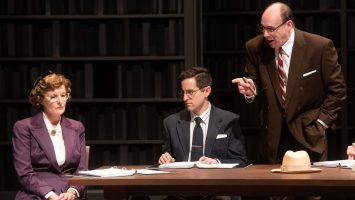
It’s easy to make bigots the villains of a story, and even easier to make a librarian the heroine. That should make “Alabama Story” a cliche-riddled play that’s easily dismissed. Fortunately, it’s much more than that.
Emily Wheelock Reed was the chief librarian for the Alabama Public Library System in 1959. She was the kind of straight-laced, devoted-to-books woman who long held positions like that. I know, because my mother was a librarian for 40 years — she would fight back against anyone who tried to block access to reading material because of any agenda that reeked of censorship.
In Reed’s case, the controversy was over “The Rabbits’ Wedding,” a picture book for children written by Garth Williams, who came to prominence as the illustrator of such classics as “Stuart Little,” “Charlotte’s Web,” and the “Little House On The Prairie” series. He also wrote and illustrated several of his own books about baby animals. Why the controversy about this Williams’ book? Because it was about a white rabbit and a black rabbit getting married in the forest while surrounded by their other animal friends. That raised the hackles of segregationists like state senator EW Higgins (based on a real life politician named EO Eddins), who demanded that Reed not only take the book off the shelves of the library’s headquarters branch in Montgomery, but also off the list of recommended books for all the other libraries in the state. Reed refused, deeming the book unobjectionable, and the battle was on.
As that story plays out, there’s also a subplot involving a white woman and a black man who were childhood friends. She grew up with privilege, daughter of a wealthy businessman, living in a big house, while he grew up the son of a woman who worked for her father, living in a ramshackle building. When they meet by accident some 20 years later, there’s a cordial familiarity and affection between the characters, although we discover there’s something more beneath their initially kind veneers. While interesting, that part of “Alabama Story” has echoes of similar stories and is not as compelling as the Reed v. Higgins dispute.
Still, the St. Louis Rep’s production of “Alabama Story” works because of its simple set and outstanding performances by all six cast members: Jeanne Paulsen as Reed, Carl Palmer as Higgins, Corey Allen and Anne O’Donoghue as the long-lost friends, Carl Howell as Reed’s assistant at the library, and especially Larry Paulsen as Williams and several other characters. Every one of them drew me in and kept me riveted.
Playwright Kenneth Jones captures the animus of that era quite well. There are obvious parallels to the bigotry still present in modern-day America — especially the Deep South. Mind you, this all took place decades before talk radio loudmouths and Fox News Channel windbags would take such a story and blow it completely out of proportion. In 1959 Alabama, that job was left to segregationist newspapers, organizations like the White Citizens Council, and politicians like Higgins, who — because the legislature determined the library’s budget — felt they had the right to determine which books should or should not be available to the public.
Jones smartly includes the comments of Williams on the controversy: “I was completely unaware that animals with white fur, such as white polar bears and white dogs and white rabbits, were considered blood relations of white human beings. I was only aware that a white horse next to a black horse looks very picturesque.” He also explained that “The Rabbits’ Wedding” was not written for adults, who “will not understand it, because it is only about a soft furry love and has no hidden message of hate.”
I give “Alabama Story” an 8.5 out of 10. It will run at the Repertory Theatre of St. Louis through January 27th.
